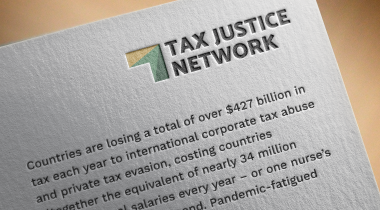
Markus Meinzer ■ The Corporate Tax Haven Index: a Joint Research Centre audit

We are pleased to publish a guest blog written by Erhart Szilárd of the European Commission’s Joint Research Centre, presenting their findings of the statistical audit of our Corporate Tax Haven Index 2019. The Tax Justice Network’s first engagement with the centre dates back to 2016, when we began engaging on the evaluation of the Financial Secrecy Index with their world-leading team on composite indices (results published in the Financial Secrecy Index 2018 methodology, pages 163-194). We are proud of this standing relationship because it helps ensure that the index work we do is robust and of internationally leading quality.
The statistical side of the tax equation: The Joint Research Centre Audit of the Corporate Tax Haven Index
By Szilárd Erhart, European Commission’s Joint Research Centre
Indexes are getting increasingly important for policy design, implementation and assessment in today’s information age. Multifaceted issues like tax evasion are difficult, if not impossible at all, to measure by a sole indicator. Information aggregated in an index can, however, effectively synthesise complex and large dataset and distil messages into user-friendly and easy-to-understand measures.
Still, we have to admit that the index development process is challenging at every stage from the conceptualisation to the measurement and communication. To support index developers in improving the reliability and transparency of their indices, the European Commission’s Competence Centre on Composite Indicators and Scoreboards (COIN) at the Joint Research Centre (JRC) in Italy, carries out statistical audits of indexes upon request of international organisations and other European Commission services. To date, over 100 indexes, in a variety of policy domains, have received tailored recommendations from our research team at the JRC.
In 2019, the Tax Justice Network reached out to JRC colleagues and requested the statistical assessment and audit of the Corporate Tax Haven Index, similar to a 2018 JRC audit of the Financial Secrecy Index. The Tax Justice Network team wanted to cross-check the methodology, the background calculations and conceptualisation of the Corporate Tax Haven Index. The JRC’s statistical assessment of the Corporate Tax Haven Index was undertaken between Dec 2019 and June 2020.
After mutually beneficial discussions in 2020, with suggestions for improvements in terms of data characteristics, structure and methods used, the JRC published the statistical audit of the Corporate Tax Haven Index. The audit focused on the statistical coherence of the structure of indicators and the impact of key modelling assumptions on the Corporate Tax Haven Index.
The Corporate Tax Haven Index methodology was found by the JRC to be coherent and thoroughly considered by experts of tax evasion. The audit showed some of the differences in scoring of Corporate Tax Haven Index indicators, their correlation with other indicators and discussed how all these can influence the final Corporate Tax Haven Index scores and rankings. The JRC suggested to weigh up the possibility of using a geometric average for the aggregation of indicators, as it may better reflect the non-compensatory nature of tax avoidance. In general, the Corporate Tax Haven Index was found to be robust, top ten ranked countries of the Corporate Tax Haven Index are in the top of other lists of tax havens in recent studies, applying different empirical methods for the identification. As recommended by the JRC team in its Financial Secrecy Index audit, it would be worthwhile to publish confidence intervals alongside the ranking.
Table 1: Top-ranked countries in corporate tax haven rankings

The development of the Corporate Tax Haven Index, like the construction of any composite indicator, involves assumptions and subjective decisions. The JRC tested the impact of varying some of these assumptions within a range of plausible alternatives in an uncertainty analysis. Here, the objective was to attempt to quantify the uncertainty in the ranks of the Corporate Tax Haven Index, which can demonstrate the extent to which countries can be differentiated by their scores. Although many assumptions made in the development of the Corporate Tax Haven Index could be examined, three particular assumptions were examined in this uncertainty analysis
1. Corporate Tax Haven Index Indicator set [Full set] vs. [Reduced set]
2. Aggregation method [Arithmetic mean] vs. [Geometric mean]
3. Weights [Randomly varied +/-25% from equal weights]
These were chosen as plausible alternative pathways in the construction of the Corporate Tax Haven Index, which can be relatively easily investigated.
The uncertainty in the Corporate Tax Haven Index rankings, given the assumptions tested, was found mostly quite modest. Country ranks could be stated to within around 13 places of precision (Figure 1), although some countries are especially sensitive to the assumptions made. This information should be also used to guide the kind of conclusions that can be drawn from the index. For example, differences of two or three places between countries cannot be taken as “significant”, whereas differences of 10 places upwards can show a meaningful difference. One can also observe that the confidence intervals are generally wider for mid-ranking countries, and narrower for top and bottom-ranking countries.
Figure 1: Simulated rankings (median values and confidence intervals)*

We expect the Corporate Tax Haven Index and its background dataset to energise tax evasion experts, to provide them with a useful benchmark and to help re-colour the black economy with colours from white to green.
Contact: [email protected]
About JRC: The Joint Research Centre (JRC) is the European Commission’s science and knowledge service. The JRC provides European Union and national authorities with solid facts and independent support to help tackle the big challenges facing our societies today. The JRC creates, manages and makes sense of knowledge, delivering the best scientific evidence and innovative tools for the policies that matter to citizens, businesses and governments. Twitter: @EU_ScienceHub
[Image: “Index Cards’ ‘DNA'” by ayalan is licensed under CC BY-NC-ND 2.0]
Related articles
The elephant in the room of business & human rights

Bad Medicine: A Clear Prescription = tax transparency
Tax justice pays dividends – fair corporate taxation grows jobs, shrinks inequality

The Financial Secrecy Index, a cherished tool for policy research across the globe

Lessons from Australia: Let the sunshine in!

Vulnerabilities to illicit financial flows: complementing national risk assessments
UN Submission: A Roadmap for Eradicating Poverty Beyond Growth

Do it like a tax haven: deny 24,000 children an education to send 2 to school

Tax Justice transformational moments of 2024


